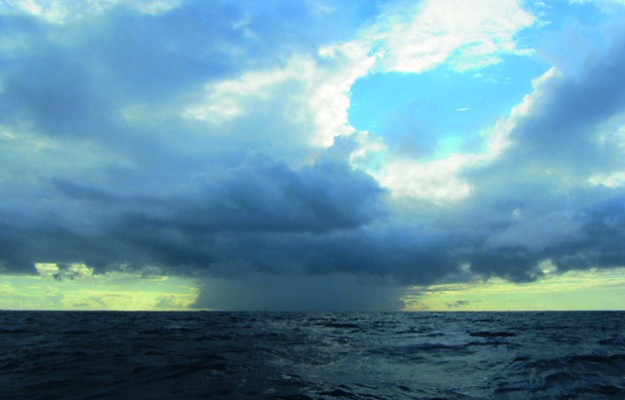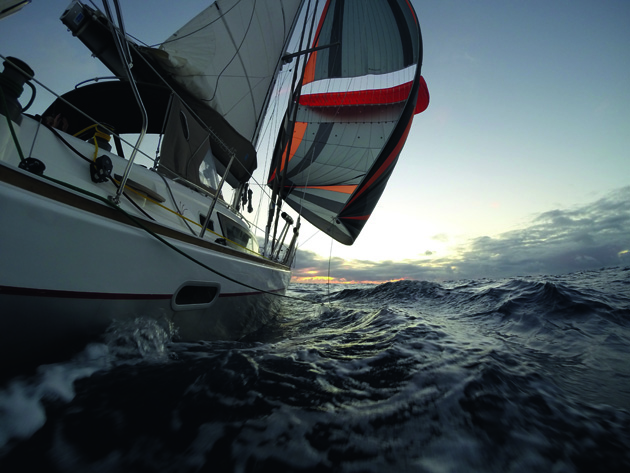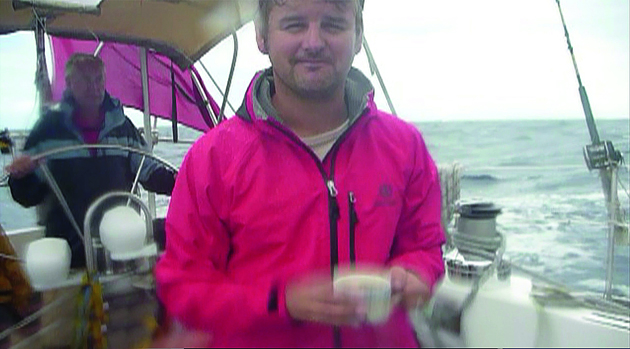Squalls in the tropics are a daunting prospect, but they needn’t be, says Dan Bower in the third part of our cruising series. Preparation is the key
 Tradewind sailing on the tropical route is often called the milk run. This is living the dream. Facing into the sunset with 15-25 knots of breeze at your back and surfing in rolling ocean swells, clocking record daily runs, are some of the reasons why every year hundreds of yachts head across oceans into the tropics and further afield. Of course, the destination also helps . . . and the rum.
Tradewind sailing on the tropical route is often called the milk run. This is living the dream. Facing into the sunset with 15-25 knots of breeze at your back and surfing in rolling ocean swells, clocking record daily runs, are some of the reasons why every year hundreds of yachts head across oceans into the tropics and further afield. Of course, the destination also helps . . . and the rum.
The fly in the ointment and probably the biggest fear for the uninitiated is the tropical squall. This can be anything from a benign gust to a deluge of torrential rain with wild windshifts, sail-splitting gusts and sustained 50 per cent increases in wind speed.
When caught unawares, a squall can be enough to challenge any sailor’s sense of enjoyment and can be petrifying and dangerous to the novice or the seriously over-canvassed.
Squalls in the tropics are usually isolated features that are too small and short-lived to be forecast on their own, though areas of increased activity can be visible and predicted; when they form in squall lines they can usually be well forecast.
Individual squalls are usually relatively brief, whereas a squall line could last for many hours. The principle for preparation, though, is the same.
The art of dealing will squalls is to identify them and prepare the boat and crew. Then they can even be enjoyed as an exhilarating and refreshing experience – as well as presenting the crew with an opportunity for a freshwater shower.
The good news is that on an Atlantic passage the frequency and intensity of the squalls increase towards the Caribbean and this is usually after you are halfway across. By then you have tradewind sailing and onboard living down to a fine art and tend to become very good at observing the clouds and spotting squalls.
Identifying a squall
Fortunately, in daytime at least, squalls can be identified clearly as a tall cloud with a flat, dark base, often with a dark slab of rain visible underneath. Owing to their make up and watery content they also usefully show up on radar, so make sure any rain filters are turned off.
At night it’s much harder to spot them and a nervous watchkeeper may see a squall in every cloud. On bright, moonlit nights clouds all seem to have a dark and threatening bottom and as a charter skipper I’m called on deck countless times to “look at that cloud”. I encourage this (although I often delegate it to the mate) as it’s an opportunity to teach identification to the crew.
If in doubt, treat it as a squall.
Tracking squalls
Squalls are generally not huge, and as often as not will pass you by. An awareness of the wind direction and how the clouds are moving will help identify it as a threat. If in any doubt, think of it in the same terms as collision avoidance with another vessel: if it’s on a constant bearing, it’s coming for you! Radar can also help; just track it like you would a ship.
If only a small course alteration is required to miss the squall, that can be very worthwhile in the long term, but anything more than that is probably not time- or energy-efficient. You’re going to have to go through one at some stage and with a good routine they don’t need to be a drama.
In lighter winds racing boats will route towards them in the hope of a quicker ride for a period and if you’re low on fresh water it can be an opportunity to fill the tanks or take an impromptu shower.
Preparations
The problem with squalls is their unpredictable and fickle nature. Sometimes a rainbow-wielding monster can have no effect on the wind speed, and sometimes it can even reduce the wind.
This can be quite an anticlimax, disappointing after the effort of dousing the spinnaker, popping in a couple of reefs and donning a light rain jacket. You can be left wallowing and sweating. Up go the sails.
Then when the next cloud looms the temptation not to bother can creep up. But the old adage holds true: ‘If you need to think about it, reef.’ The one time you don’t, you may really wish you had.
Reefing
Reducing sail is the first thing to consider, and doing it early really helps. On many contemporary masts, swept-back spreaders do not allow you to reef when deep downwind, and once the squall kicks in, the idea of coming up into the breeze and swell is not a pleasant one. If you’re brave enough to have a spinnaker up, take it down.
On Skyelark we usually run downwind with a poled-out headsail and it is usually sufficient to furl this away and sail deep downwind, keeping a slight angle to the swell and wind to be safe from a gybe. As long as the mainsail is adequately reefed for the prevailing conditions, the lack of headsail should easily compensate for the increase in wind speed.
If you get caught with the kite up or you are unable to reef and you have a proficient helm, it can often be best to stick with your current sail plan. Just be prepared to blow the kite completely (that is, let everything go, even the halyard) if it becomes too much. Unless you have a slick crew, dropping a spinnaker in a squall can be dangerous.
Go with the blow
Most squall damage tends to be caused by a big windshift which, if you’re not on the ball, can easily result in an unintentional gybe. This tends to be the cause of many a broken kicker (vang), gooseneck or boom. The two most important things are a preventer rigged properly to the end of the boom and led forward, preferably to the bow and back; and your helmsman or autopilot tuned into wind angle not compass course.
The windshifts can be dramatic and it is not uncommon to find yourself heading in entirely the wrong direction for a time, and in some cases even doing a 360°! It’s best not to be too concerned about this and stick with the wind; it won’t be long until it has passed and you’re back on track. Any time spent in gybing for the new wind angle will be wasted when the prevailing wind re-establishes after the squall, and your crew might not all appreciate being called on deck for manoeuvres in the rain.
Do’s and don’ts
√ Do reef early in preparation. If you have a spinnaker up, take it down
√ Do brief the crew on what to look for in a squall cloud and make it clear to wake the skipper if they are in any doubt
√ Do use radar to monitor the track of the squall
√ Do make the effort to don waterproofs – even in the tropics it can get chilly if you are soaked through
√ Do make sure lines and halyards are kept tidy so they are ready to run if you need to reef quickly
√ Do hand steer or set the autopilot to wind angle
x Don’t underestimate the force of wind that may be in the squall
ý Don’t leave it to the last minute to shorten sail
x Don’t Don’t fly the spinnaker at night if there have been squalls in the area.
Top tips
- We always have two people on watch, with both skipper and mate out of the watch system, so if things need to be done quickly there are four of us at the ready.
- After or before the squall there maybe a drop in wind and sometimes it’s better to motor through it.
- Be ready for a sudden change of wind direction. Have your best helmsman at the helm and the gybe preventer well secured.
- Make sure the crew know where the preventer is secured in case it needs to be released at night.
- As a general rule, if you see rain in a squall, assume there is going to be plenty of wind around it. The gust fronts will vary in strength, and the higher the clouds and the faster they are moving, the stronger the wind will be. You can get sudden initial gusts of gale force strength, which will come on suddenly though they are likely to die away fairly quickly as well.
- If you don’t see rain in the squall you can still get stronger gusts near the edges, but these usually don’t contain too much wind.
- If you are sailing under plain sails with a headsail set on a pole rigged with foreguy and afterguy, you have an advantage in squally conditions as the foresail can be quickly rolled away or reduced, leaving the pole in position.
- A snuffer is a great thing for long-distance sailing as a sail can be doused quickly and doesn’t need to be packed again in a bag, and it speeds up reducing sail ahead of a squall. Even so, going from spinnaker to poled-out headsail needs more crew and avoiding twists in the snuffer can take a bit of practice.
- Twin headsails is a sailplan that is not so fashionable these days, but some crews swear by it. One thought worth consideration is how easy this will be to reduce or roll away in a squall; without the blanketing effect of a mainsail it can be quite a handful in sudden, strong winds.
- The same goes for a spinnaker or Parasailor flown on its own without a mainsail.
Dan and Em Bower
Dan and Em Bower, both in their thirties, are lifelong sailors. Six years ago they bought Skyelark of London, a Skye 51 by American designer Rob Ladd, built in Taiwan in 1986, and have been sailing and chartering her ever since, making some 12 transatlantic crossings and covering around 60,000 miles.
Part 4: Sailing with a poled-out headsail
Essential guide to setting up a downwind sailing rig for stress-free cruising
See videos for all the parts here
12-part series in association with Pantaenius








